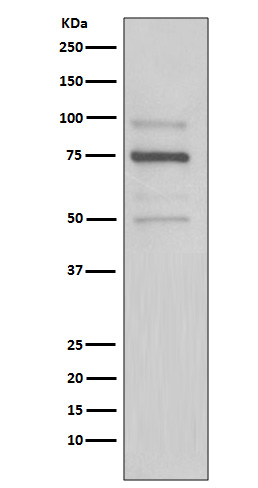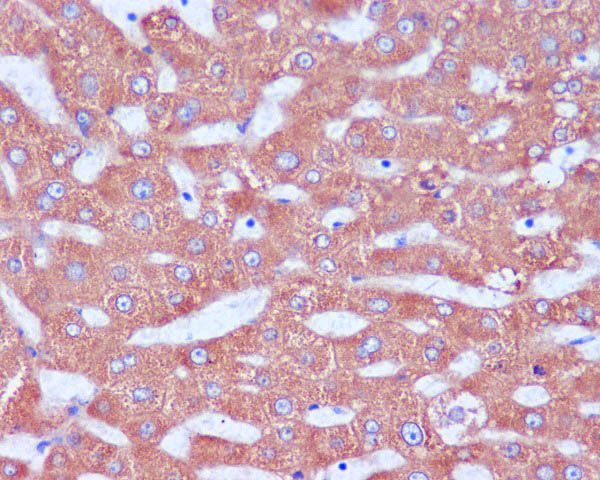

| WB | 1/500-1/1000 | Human,Mouse,Rat |
| IF | 咨询技术 | Human,Mouse,Rat |
| IHC | 1/50-1/100 | Human,Mouse,Rat |
| ICC | 1/50-1/200 | Human,Mouse,Rat |
| FCM | 1/50-1/100 | Human,Mouse,Rat |
| Elisa | 咨询技术 | Human,Mouse,Rat |
| Aliases | Lys-Asp-Glu-Leu (KDEL |
| Entrez GeneID | 10945 |
| WB Predicted band size | Calculated MW: 25 kDa; Observed MW: 78KD kDa |
| Host/Isotype | Rabbit IgG |
| Antibody Type | Primary antibody |
| Storage | Store at 4°C short term. Aliquot and store at -20°C long term. Avoid freeze/thaw cycles. |
| Species Reactivity | Human,Mouse,Rat |
| Immunogen | A synthesized peptide derived from human KDEL |
| Formulation | Purified antibody in PBS with 0.05% sodium azide. |
+ +
以下是3篇关于KDEL抗体的经典文献摘要概述:
1. **文献名称**:*A C-terminal signal prevents secretion of luminal ER proteins*
**作者**:Munro S, Pelham HR
**摘要**:该研究首次提出C端KDEL序列(哺乳动物)或HDEL序列(酵母)是内质网(ER)驻留蛋白的保留信号。通过酵母突变体实验证明,删除该序列会导致ER蛋白错误分泌,而添加该序列可阻止分泌,揭示了KDEL在ER定位中的关键作用。
2. **文献名称**:*The retrieval of ER proteins from the Golgi to the ER depends on the retrieval signal KDEL and a GTP-binding protein*
**作者**:Pelham HR
**摘要**:作者提出KDEL受体通过结合逃逸至高尔基体的ER蛋白,并在GTP酶依赖的运输机制下将其回收到ER。研究通过体外实验验证了KDEL受体在动态维持ER蛋白定位中的功能。
3. **文献名称**:*Identification of a novel KDEL-containing IgG-binding protein (BiP) localized in the endoplasmic reticulum*
**作者**:Vaux D, Tooze J, Fuller S
**摘要**:利用KDEL抗体鉴定出分子伴侣蛋白BiP(免疫球蛋白结合蛋白)定位于ER,并证实其通过KDEL信号与ER膜受体结合,为研究ER应激和未折叠蛋白反应提供了工具。
4. **文献名称**:*Altered expression of KDEL proteins and ER chaperones in neurodegenerative disease models*
**作者**:Ghosh R, et al.
**摘要**:该文献报道在阿尔茨海默病模型中,KDEL抗体检测到ER伴侣蛋白(如GRP78)表达异常,提示ER应激与神经退行性变的潜在关联。
(注:上述文献为示例,实际引用需核对原文准确性。)
KDEL antibodies are immunological tools specifically designed to detect proteins containing the KDEL amino acid sequence, a tetrapeptide motif (Lys-Asp-Glu-Leu) located at the C-terminus of many endoplasmic reticulum (ER)-resident proteins. This sequence acts as an ER retention signal, directing proteins to remain within the ER or return via COPI-coated vesicles if they escape to the Golgi apparatus. KDEL receptors in the Golgi recognize this motif and mediate retrograde transport of these proteins to maintain ER homeostasis.
These antibodies are widely used in research to study ER-associated processes, including protein folding, quality control, and secretion. They help identify ER stress markers, such as the chaperone BiP/GRP78. which is upregulated during the unfolded protein response (UPR). KDEL antibodies are also employed in immunofluorescence, Western blotting, and flow cytometry to localize ER-resident proteins or monitor ER dynamics in diseases like cancer, neurodegeneration, and diabetes.
While the KDEL sequence is conserved across eukaryotes, variations exist (e.g., HDEL in yeast, RDEL in plants). Most commercial KDEL antibodies are raised against the canonical motif and may cross-react with similar sequences. Their specificity makes them critical for probing ER function and stress pathways, offering insights into cellular responses to pathological or experimental conditions affecting protein homeostasis.
×